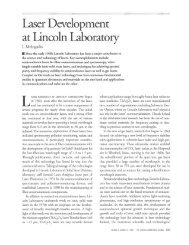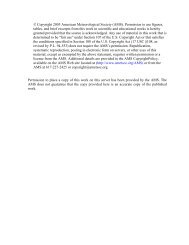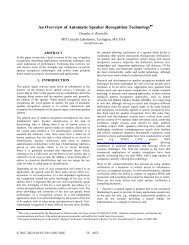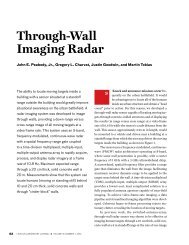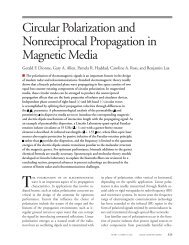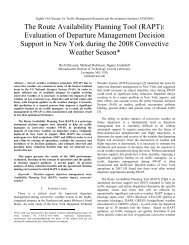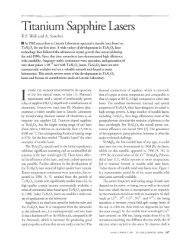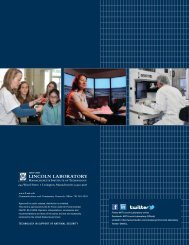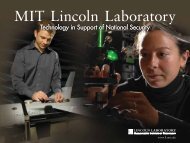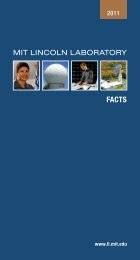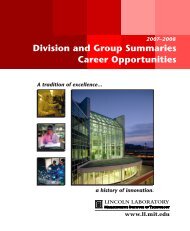Automated Flight Strip Management System Functional Description
Automated Flight Strip Management System Functional Description
Automated Flight Strip Management System Functional Description
You also want an ePaper? Increase the reach of your titles
YUMPU automatically turns print PDFs into web optimized ePapers that Google loves.
4.4.1.4 Taxiing<br />
Aircraft receive clearance to "push back" and taxi to the departure runway from the<br />
Ground Control controller position. Once an aircraft crosses into the "movement area" it is<br />
under the jurisdiction ofGround Control. The nominal division ofresponsibility between<br />
Ground Control and the Tower, as described in the Airman's Information Manual, is for<br />
Ground Control to control aircraft on the ground until they are ready for departure. The<br />
Local Controller controls the active runways for arriving and departing aircraft. The<br />
Ground Control position must coordinate crossings of the active runways with the Local<br />
Controller. Permission for the pilot to cross runways, including active runways, is implicit<br />
in the clearance to taxi to an active runway given by Ground Control unless specifically<br />
prohibited by the use of instructions to "hold shon" of a runway. From paragraph 241 a.<br />
(5) of the Airman's Information Manual:<br />
When ATC clears an aircraft to "taxi to" an assigned takeoff<br />
runway, the absence of holding instructions authorizes the aircraft to<br />
"cross" all runways which the taxi route intersects except the<br />
assigned takeoff runway. It does not include authorization to "taxi<br />
onto" or "cross" the assigned takeoff runway at any point. In order<br />
to preclude misunderstandings in radio communications, ATC will<br />
not use the word "cleared" in conjunction with authorization for<br />
aircraft to taxi.<br />
Boston Logan follows this convention and the Ground Controller must coordinate<br />
with the Local Controller any time an aircraft crosses an active runway. The use of "hold<br />
shoo" instructions is common. There can be more than one active runway depending on<br />
the airpon configuration. The airpon configuration, in tum, depends on the surface winds,<br />
noise abatement procedures, and traffic. A given airpon configuration has cenain runways<br />
used for departures, arrivals or both. For a given airport configuration all runways in use<br />
are considered active regardless of the "rate" of use of that runway. It is possible for an<br />
aircraft to use a runway that is not considered active for the airpon configuration in effect<br />
at the time. For example, the primary departure runway(s) may be too shon for an aircraft<br />
in the heavy category or a high performance military jet fighter. In that case the aircraft can<br />
be cleared to takeoff on a longer runway after coordination with the departure controller.<br />
Coordination with departure would not be required ifthe runway was considered an active<br />
runway for the airpon configuration. In point of fact, any runway can be requested by a<br />
pilot for take-off or landing in any direction, regardless ofthe airpon configuration, but as<br />
a practical matter such a request could result in a long delay. It is the pilot's responsibility<br />
to ensure that the runway assigned is adequate for the performance of his or her airplane.<br />
4.4.1.5 Take-Off<br />
After an aircraft has crossed all active runways on its taxi route and is approaching<br />
the end of the departure runway it will be instructed by Ground Control to monitor the<br />
Tower frequency. When departure traffic is high, there will be a queue at the end of the<br />
departure runway. Aircraft will continue to monitor the Tower frequency while in the<br />
queue. As aircraft enter the queue, the Ground Controller transfers the <strong>Flight</strong> Progress<br />
<strong>Strip</strong>s to the Local Controller in sequence. This is the stack that is viewed on the television<br />
monitors in the TRACON. Ifthe aircraft is going to use a runway other than a primary<br />
departure runway, this will be coordinated with the departure controller in the TRACON<br />
and written on the <strong>Flight</strong> Progress <strong>Strip</strong>. Aircraft do not contact the Tower when they are<br />
ready to take-off. Instead, the Local Controller knows the aircraft identification and call<br />
signs by virtue of their <strong>Flight</strong> Progress <strong>Strip</strong>s and will contact the aircraft directly as they<br />
become first in line. When there is more than one primary runway in use for departures,<br />
23



